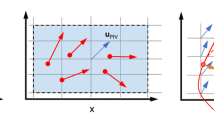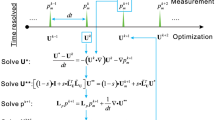Abstract
A procedure is introduced to obtain an instantaneous pressure field around a wing from time-resolved particle image velocimetry (TR-PIV) and particle image accelerometry (PIA). The instantaneous fields of velocity and material acceleration are provided by the recently introduced multi-frame PIV method, fluid trajectory evaluation based on ensemble-averaged cross-correlation (FTEE). The integration domain is divided into several subdomains in accordance with the local reliability. The near-edge and near-body regions are determined based on the recorded image of the wing. The instantaneous wake region is assigned by a combination of a self-defined criterion and binary morphological processes. The pressure is reconstructed from a minimization process of the difference between measured and reconstructed pressure gradients in a least-square sense. This is solved sequentially according to a decreasing order of reliability of each subdomain to prevent a propagation of error from the less reliable near-body region to the free-stream. The present procedure is numerically assessed by synthetically generated 2D particle images based on a numerical simulation. Volumetric pressure fields are then evaluated from tomographic TR-PIV of a flow around a 30-degree-inclined NACA0015 airfoil. A possibility of using a different scheme to evaluate material acceleration for a specific subdomain is presented. Moreover, this 3D application allows the investigation of the effect of the third component of the pressure gradient by which the wake region seems to be affected.















Similar content being viewed by others
References
Astarita T (2007) Analysis of weighting windows for image deformation methods in PIV. Exp Fluids 43:859–872
Charonko JJ, King CV, Smith BL, Vlachos PP (2010) Assessment of pressure field calculations from particle image velocimetry measurements. Meas Sci Technol 21:105401
Cierpka C, Lütke B, Kähler CJ (2013) Higher order multi-frame particle tracking velocimetry. Exp Fluids 54:1–12
Dabiri JO, Bose S, Gemmell BJ, Colin SP, Costello JH (2014) An algorithm to estimate unsteady and quasi-steady pressure fields from velocity field measurements. J Exp Biol 217(3):331–336
David L, Jardin T, Farcy A (2009) On the non-intrusive evaluation of fluid forces with the momentum equation approach. Meas Sci Technol 20:095401
de Kat R, van Oudheusden BW (2012) Instantaneous planar pressure determination from PIV in turbulent flow. Exp Fluids 52:1089–1106
Ferziger JH, Peric M (2002) Computational methods for fluid mechanics, Springer, Berlin
Guezennec YG, Brodkey RS, Trigui N, Kent JC (1994) Algorithms for fully automated three-dimensional particle tracking velocimetry. Exp Fluids 17:209–219
Harker M, O’Leary P (2008) Least squares surface reconstruction from measured gradient fields. IEEE Computer Vision and Pattern Recognition, Anchorage
Herrmann J (1980) Least-squares wave front error of minimum norm. J Opt Soc Am 70:28–35
Huhn F, Schanz D, Gesemann S, Schröder A (2016) FFT integration of instantaneous 3D pressure gradient fields measured by Lagrangian particle tracking in turbulent flows. Exp Fluids 57:151. https://doi.org/10.1007/s00348-016-2236-3
Jensen A, Pedersen GK, Wood DJ (2003) An experimental study of wave run-up at a steep beach. J Fluid Mech 486:161–188
Jeon YJ, Chatellier L, David L (2014) Fluid trajectory evaluation based on an ensemble-averaged cross-correlation in time-resolved PIV. Exp Fluids 55:1–16
Jeon YJ, Chatellier L, Beaudoin A, David L (2015) Least-square reconstruction of instantaneous pressure field around a body based on a directly acquired material acceleration in time-resolved PIV. In: 11th International Symposium on Particle Image Velocimetry-PIV15. Santa Barbara, California, September 14–16
Lecordier B, Westerweel J (2004) The EUROPIV synthetic image generator. In: Stanislas M, Westerweel J, Kompenhans J (eds) Particle image velocimetry: recent improvements. Springer, Heidelberg
Li D, Zhang Y, Sun Y, Yan W (2008) A multi-frame particle tracking algorithm robust against input noise. Meas Sci Technol 19:105401
Liu X, Katz J (2003) Measurements of pressure distribution by integrating the material acceleration. In: Cav03-GS-14-001. In: Fifth international symposium on cavitation (CAV2003), Osaka, Japan, 1–4 November, 2003
Liu X, Katz J (2006) Instantaneous pressure and material acceleration measurements using a four-exposure PIV system. Exp Fluids 41:227–240
Liu X, Katz J (2013) Vortex-corner interactions in a cavity shear layer elucidated by time-resolved measurements of the pressure field. J Fluid Mech 728:417–457
Liu X, Moreto JR, Siddle-Mitchell S (2016) Instantaneous Pressure Reconstruction from Measured Pressure Gradient using Rotating Parallel Ray Method. In: 54th AIAA Aerospace Sciences Meeting, 4–8 January 2016, San Diego
Lynch KP, Scarano F (2013) A high-order time-accurate interrogation method for time-resolved PIV. Meas Sci Technol 24:035305
Lynch KP, Scarano F (2014) Material acceleration estimation by four-pulse tomo-PIV. Meas Sci Technol 25:084005
Malik NA, Dracos T, Papantoniou DA (1993) Particle tracking velocimetry in three-dimensional flows. Exp Fluids 15:279–294
Murai Y, Nakada T, Suzuki T, Yamamoto F (2007) Particle tracking velocimetry applied to estimate the pressure field around a Savonius turbine. Meas Sci Technol 18(8):2491–2503
Press WH, Teukolsky SA, Vetterling WT, Flannery BP (2002) Numerical recipes in C/C++. The Press Syndicate of the University of Cambridge, Cambridge
Raffel M, Willert CE, Kompenhans J (1998) Particle image velocimetry: a practical guide. Springer, Berlin, Heidelberg, New York
Scarano F, Riethmuller ML (2000) Advances in iterative multigrid PIV image processing. Exp Fluids 29(1):S051–S060
Schneiders JFG, Scarano F (2016) Dense velocity reconstruction from tomographic PTV with material derivatives. Exp Fluids 57(9)
Sciacchitano A, Scarano F, Wieneke B (2012) Multi-frame pyramid correlation for time-resolved PIV. Exp Fluids 53:1087–1105
Southwell WH (1980) Wave-front estimation from wave-front slope measurements. J Opt Soc Am 70:998–1006
Theunissen R, Scarano F, Riethmuller ML (2008) On improvement of PIV image interrogation near stationary interfaces. Exp Fluids 45(4):557–572
Thomas L, Tremblais B, David L (2014) Optimization of the volume reconstruction for classical Tomo-PIV algorithms (MART, BIMART and SMART): synthetic and experimental studies. Meas Sci Technol 25(3):035303
Tronchin T, David L, Farcy A (2015) Loads and pressure evaluation of the flow around a flapping wing from instantaneous 3D velocity measurements. Exp Fluids 56(7):1–16
van Oudheusden BW (2013) PIV-based pressure measurement. Meas Sci Technol 24:032001
Van Gent PL, Michaelis D, Van Oudheusden BW, Weiss P, De Kat R, Laskari A, Gesemann S et al (2017) Comparative assessment of pressure field reconstructions from particle image velocimetry measurements and Lagrangian particle tracking. Exp Fluids 58(4):33
Violato D, Moore P, Scarano F (2011) Lagrangian and Eulerian pressure field evaluation of rod-airfoil flow from time-resolved tomographic PIV. Exp Fluids 50:1057–1070
Wang Z, Gao Q, Wang C, Wei R, Wang J (2016) An irrotation correction on pressure gradient and orthogonal-path integration for PIV-based pressure reconstruction. Exp Fluids 57:104
Wang CY, Gao Q, Wei RJ, Li T, Wang JJ (2017) Spectral decomposition-based fast pressure integration algorithm. Exp in Fluids 58(7):84
Westerweel J, Scarano F (2005) Universal outlier detection for PIV data. Exp Fluids 39:1096–1100
Acknowledgements
The current work has been conducted as part of the NIOPLEX project, Non-intrusive Optical Pressure and Loads Extraction for Aerodynamic Analysis, funded by the European Commission program FP7, Grant No. 605151 and as part of the EVAPOR Astrid project, funded by the Agence Nationale de la Recherche and the DGA, Grant No. NR-16-ASTR-0005-01.
Author information
Authors and Affiliations
Corresponding author
Rights and permissions
About this article
Cite this article
Jeon, Y.J., Gomit, G., Earl, T. et al. Sequential least-square reconstruction of instantaneous pressure field around a body from TR-PIV. Exp Fluids 59, 27 (2018). https://doi.org/10.1007/s00348-018-2489-0
Received:
Revised:
Accepted:
Published:
DOI: https://doi.org/10.1007/s00348-018-2489-0




